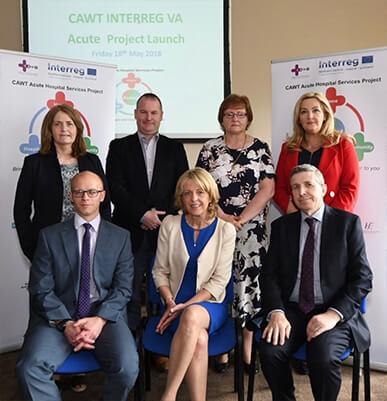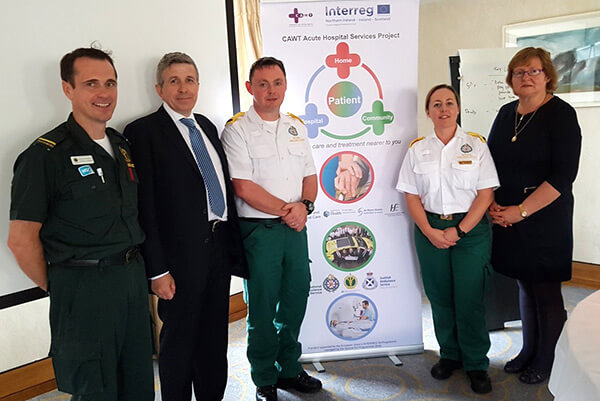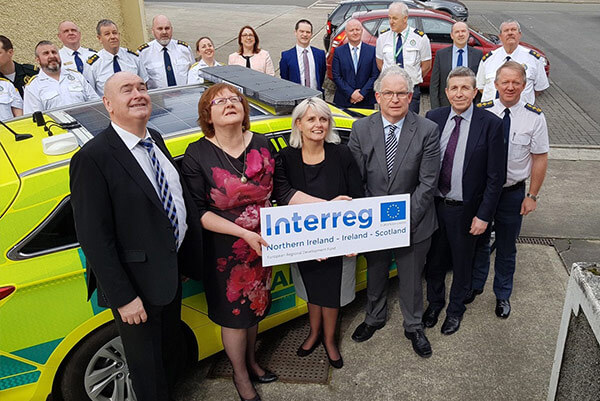On May18, the CAWT (Co-operation & Working Together) led Interreg VA Acute Project was formally launched at Letterkenny University Hospital, writes Seán Murphy, Chair CAWT Acute Strategy Board and General Manager, Letterkenny University Hospital.

Back Row (L to R), Ms.Louise Potts, Project Manager CAWT Acute Project Board, Dr.Ray Nethercott, CAWT eHealth Strategic Group, Mrs.Bernie McCrory OBE, Chief Officer CAWT amd Ms.Gina McIntyre, CEO, SEUPB.
The event was attended by healthcare leaders and clinicians representing the participating organisations across the three jurisdictions of Scotland, Northern Ireland, and the Republic of Ireland.
The CAWT Acute Project will see €13m invested in acute healthcare in the border regions of the three participating jurisdictions with a benefit to at least 13,000 patients. Funding for these projects is provided from the European Union’s Regional Development Fund.
The CAWT Acute Project Board identifies projects which meet the objectives of both the Interreg Programme and of CAWT and which also meet specific population health needs within the eligible border regions. The goal is to improve cross-border cooperation through initiatives that maximise the infrastructure within the border regions and share learning, expertise and best practice. Our projects reform and modernise healthcare delivery through the development of new service models. Many of our projects spearhead the introduction of new technologies to facilitate the local delivery of care, thus stimulating innovation in the delivery of services amongst some of the most deprived communities in the border regions.
The CAWT Interreg VA Acute Project consists of three Frameworks to be delivered between 2017 and 2021. Initiatives within these frameworks will reduce boundaries as an impediment to appropriate access to safe and effective healthcare, whether such boundaries or border be political, organisational, or those between acute, primary, and community care.

Framework 1, Reform and Modernisation of Unscheduled Care, will see over 6,500 patient beneficiaries and over 200 staff trained across the RoI, NI, and Scotland. The projects included in this framework include the development of a Clinical Decision Unit in Daisy Hill Hospital, Newry; an A&E Reform Project supporting hospitals in both Northern Ireland and the border counties of the Republic of Ireland; piloting a Consultant Geriatrician led Community based service and a community delivered Cardiac Investigation Service both based in Sligo and serving the Sligo and South Fermanagh.
The final project within this framework is also one of the most innovative on this island. The Community Paramedic Project is based on an initiative developed in Scotland and is being piloted in Buncrana, Co.Donegal, Clones, Co. Monaghan and Castlederg, Co.Tyrone. The project also has a hub in Argyle, Scotland.
This project is providing advanced training to paramedics who undertake assessment of patients in a community setting, providing treatment and interventions where appropriate or arranging transport to a medical facility when required. The range of treatments provided are considerably more extensive than the standard paramedic response and include prescribing certain medicines, re-siting catheters, administering intravenous medications etc. The project aims to provide a more patient centred and responsive service, treating patients in their home or residential facility, and reducing the need for patients to be transferred to hospital for treatments that could be provided elsewhere.The three strands within Frameworks 2 and 3, Reform and Modernisation of Out-Patient, Diagnostic, and Scheduled Care Services, are Dermatology, Urology and Vascular Surgery which between them will deliver over 6,500 patient beneficiaries.

The Dermatology Project includes the development of photo-dermatology triage and advice to GPs across Northern Ireland and Scotland, exploiting technological solutions to provide timely treatment to high risk patients whilst allowing appropriate patients to be managed in primary care. A second initiative will be to deliver dermatology treatments such as phototherapy in an out-patient environment in Letterkenny University Hospital. Both initiatives involve developing specialist dermatology nursing support, responding to the challenges across the NHS and HSE in meeting patient need via the traditional medical staff model.
The Urology and Vascular Projects address the deficit of urology capacity within the north-west and we are working with the Saolta University Healthcare Group and Western Health and Social Care Trust to develop effective and sustainable urology and venous services in the region, reducing the need for patients to travel significant distances to access appropriate care. This collaboration facilitates the delivery of urology at LUH and Altnagelvin hospitals and venous day surgery at Omagh Hospital and Primary Care Complex and the South West Acute Hospital in Enniskillen.
Supporting all three frameworks, the Interoperability Project aims to identify opportunities and overcome obstacles to the smooth sharing of clinical information between the jurisdictions. Thereby supporting not only of the CAWT Interreg Projects but also of existing and future healthcare collaborations between our partner organisations.
Conclusion
The CAWT Interreg Projects stimulate collaboration and innovation within the border region by providing funding for experimentation and a platform for collaboration between our partner health care systems. Delivering our projects is not without its challenges as system and organisational cultures, aspirations, and political expectations do not always align. However, our past experience of CAWT Interreg Projects and experience to date of Interreg VA demonstrate that in overcoming these challenges there is transferable learning and ever stronger relationships are forged not just within the participating organisations but also amongst our wider healthcare systems. This is reflected in the fact that 85% of Interreg IV Acute Projects were mainstreamed following the cessation of the EU funding.
InterregVA will provide direct benefit to the population and clinical staff within the eligible areas and participating organisations. More importantly, the learning and proof of concept associated with successfully delivering these innovative and transformative projects provide an opportunity for future roll-out across the border regions and indeed across the wider health care systems who share these borders. As an example we look forward to seeing Community Paramedics working in the future as far apart as Dingle, Larne and Dumfries – remembering that it started here first!

